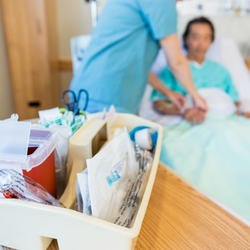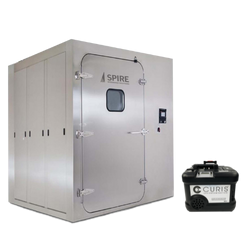Better Disinfection for Non-Critical Medical Equipment
Non-Critical Medical Items can Harbor Infectious Microbes
 In recent years, a heavy emphasis has been placed on mitigating nosocomial infections following a consistent spike in cases. Addressing infection control concerns is an important way to find lapses in disinfection protocols to prevent further infections. Critical and semi-critical medical equipment is often seen as the primary concern of spreading infections due to their invasive nature and contact with broken skin. Medical equipment that is used on patients is classified into three categories based on their risk of transmitted infection and is required to be disinfected using specific methods. Critical items are items that are going to enter vasculature or sterile tissue and include equipment like catheters and surgical instruments. Semi-critical items are any items that touch mucous membranes or broken skin like endotracheal tubes and laryngoscopes. Non-critical items only touch skin that is unbroken and are the most commonly used category in healthcare. Some examples include stethoscopes, pulse oximeters, blood pressure cuffs, and patient beds. Establishing an effective disinfection protocol using an automated system can help reduce infection rates on non-critical items and a method to efficiently disinfect them could help save money while protecting vulnerable patients.
In recent years, a heavy emphasis has been placed on mitigating nosocomial infections following a consistent spike in cases. Addressing infection control concerns is an important way to find lapses in disinfection protocols to prevent further infections. Critical and semi-critical medical equipment is often seen as the primary concern of spreading infections due to their invasive nature and contact with broken skin. Medical equipment that is used on patients is classified into three categories based on their risk of transmitted infection and is required to be disinfected using specific methods. Critical items are items that are going to enter vasculature or sterile tissue and include equipment like catheters and surgical instruments. Semi-critical items are any items that touch mucous membranes or broken skin like endotracheal tubes and laryngoscopes. Non-critical items only touch skin that is unbroken and are the most commonly used category in healthcare. Some examples include stethoscopes, pulse oximeters, blood pressure cuffs, and patient beds. Establishing an effective disinfection protocol using an automated system can help reduce infection rates on non-critical items and a method to efficiently disinfect them could help save money while protecting vulnerable patients.
Establishing the Link Between Non-Critical Items and an Efficient Disinfection Method
Disinfection methods for non-critical items often include using low-level disinfection methods and non-germicidal detergents. However, when contaminated with high-level spores or bacteria, these methods might not be enough to kill these pathogens on surfaces. For this reason, a high-level disinfection process capable of killing C.diff spores easily would be needed.
Implementing an Efficacious Disinfection Protocol
Noncritical items are vital in the medical field. Instead of overlooking this equipment, implementing a disinfection treatment protocol may be beneficial. A multi-prong approach can be taken to address these concerns and help reduce the likelihood of a patient developing a nosocomial infection and protecting the most vulnerable patients.
- Wipe down equipment with a disinfectant after each use. This minimizes the number of pathogens that could spread to the next patient.
- If you are on the clinical team and your patient is in isolation, opt for using a disposable stethoscope instead of your personal one unless it is absolutely needed. This can help prevent transmission of pathogens to the next patient.
 Practice good hand hygiene. This step has been proven as a crucial step to help stop the spread of infection.
Practice good hand hygiene. This step has been proven as a crucial step to help stop the spread of infection.- Utilize automated disinfection that gets into the nooks and crevices of the equipment for an efficacious clean. This may be used within a room or a chamber.
- Even if the equipment does not look visually contaminated, it might still be contaminated so clean the items before disinfection.
- Incorporate the use of a reprocessing chamber to treat all sealed reusable non-critical items. This will save time, supplies, and money.
While low-level disinfectants and non-germicidal detergents are commonly used on non-critical items, opting for an EPA registered high-level disinfectant can be beneficial because it targets higher level organisms that might not be eliminated using standard protocol, like Candida albicans. Currently, the guidelines on disinfection of non-critical items are vague. While it is recommended to perform disinfection treatments regularly, this varies by facility and often by the healthcare workers themselves. A more standardized approach should be considered.
Automated Disinfection: The CURIS Difference
Automated disinfection systems are a valuable resource in the healthcare space due to their efficacy and ability to reduce bioburden. Because these systems are automated, staff can start the disinfection treatment from outside of the room, protecting them from both pathogens and chemicals. CURIS System Hybrid Hydrogen Peroxide™ (HHP™) fogging technology is a revolutionary automated disinfection system that employs a 7% hydrogen peroxide solution. Integrated patented Pulse™ technology helps engulf a room in a hydrogen peroxide dry fog while maintaining a consistent dwell time to ensure a 6-log reduction (99.9999%) * on even the hardest to kill bacterial spores, like Geobacillus stearothermophilus or C. difficile. It is ideal for the healthcare environment because it can be used in a room with electronic equipment without damaging or corroding it like other high consequence automated disinfection options. Since the system is efficacious for a room and its contents, it can reach in the nooks and crevices of patient areas and the noncritical items like the bed, blood pressure cuffs, and pulse oximeter devices can be targeted simultaneously. This type of powerful disinfection treatment option can be implemented after each patient, especially those who have been colonized with MDROs. The paired combination of the CURIS fogger and solution remain on the EPA Lists K and N for efficacy against SARS-CoV-2 (COVID-19) and C. diff, a well-known MDRO. The disinfection treatments can be logged, monitored, and tracked via a tablet and Geobacillus stearothermophilus biological indicators can be placed in the space to verify the efficaciousness of the treatment. Implementing CURIS System fogging technology to your facility can target MDROs and easily breaks down into water and oxygen after the treatment for easy dissipation and no sticky or corrosive residues. Reviewing these efforts and protocols can more importantly address the growing challenges associated with noncritical items in the healthcare space.
To learn more about how CURIS System HHP™ Fogging Technology could benefit your healthcare facility, visit our Healthcare industry page.
Sources
Lee, R., Choi, S.-M., Jo, S. J., Han, S., Park, Y. J., Choi, M. A., & Kong, B. K. (2021, April 22). A quasi-experimental study on stethoscopes contamination with multidrug-resistant bacteria: Its role as a vehicle of transmission. PLOS ONE. Retrieved March 3, 2022, from https://journals.plos.org/plosone/article?id=10.1371%2Fjournal.pone.0250455
Desai, F., Perrie, H., & Fourtounas, M. (2019). Contamination of pulse oximeter probes before and ... - scielo. SAJCC. Retrieved March 3, 2022, from http://www.scielo.org.za/pdf/sajcc/v35n2/05.pdf
Eldor, J. (2018, October 18). Reusable Blood Pressure Cuff-A Real Infectious Danger during Surgery. Is it Time for Disposable Blood Pressure Cuff? Innovationinfo. Retrieved March 3, 2022, from https://www.innovationinfo.org/articles/JHSD/JHSD-115.pdf
Klacik, S. (2019, March 5). 'noncritical' or items deserve due diligence in disinfection. OR Manager. Retrieved March 3, 2022, from https://www.ormanager.com/noncritical-items-deserve-due-diligence-disinfection/
Johnson, L., Nutt, A., Piatek, D., Reese, S., Rindells, J., & Schommer, K. (2021). Strategies to mitigate cross contamination of non-critical medical devices. APIC. Retrieved March 3, 2022, from https://apic.org/noncritical-is-critical/